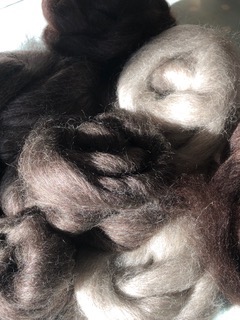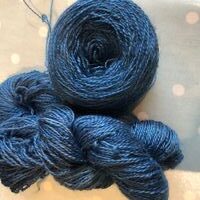I will be attending the Defashion Dorset weekend on the 24th and 25th of May, on Friday I will be running a small workshop from 10:30 – 12:30, and this a Beginners Lace Knitting. Details are available on the website https://www.hawkersfarm.org/dorset-art-weeks
Many years ago – about 25 or more – I went to a local Agricultural Show and put my hands on the back of what I learned to be a Black Wensleydale and my heart sang. The warmth of the fleece, the feel of its silkiness, the sheer size of the animal, its black tongue and full throated voice and its total presence took me by storm. I kept the Breeder’s name: Dr. Jeannie Muddle. Several years passed and I finally acquired 2 in-lamb ewes. That was my baptism into Black Wensleydales.
I had no idea what would transpire over the next 20 years, but such is the force of passion for something it takes us where it wants not where we think we will go. The next decade brought much learning, many mistakes made and loads of questions. I had to navigate my way through Sussex floods, Foot and Mouth, new viruses and diseases inherited from the land itself.
Being the rejects of the large textile wether flocks up in Yorkshire, black lambs were usually killed at birth because they would contaminate the purity of the white fleeces already established as the backbone of the textile industry and worsted spun for fine cloth. Now, ironically black fleeces can fetch top prices for weaving and spinning. The Golden Fleece competition has recently been won by a black ram fleece more than once. I searched for new bloodlines to strengthen the tiny gene pool and after 10 years felt I was producing a few quality lambs. Semen went to the states.
This was a time of experimentation and discovery. Gradually I found interests lay in hand dyeing, designer knitting, and finally fibre art with my own fleece production serving all of these with a few white wethers bought from friends to add to the mix.
In 2021I moved to the Dorset/Wilts border and the last few Wensleydale’s were culled having reached an age that precluded re-homing them.
During this period, I had much help from British Wool, had my fleece quality verified by them, learned a lot only to discover it was a fraction of what I needed to know! The core of my research taught me that Wensleydale fibre Is the finest lustre Long Wool in the world and that the sheep knew it.

Diamond Fibre Spinning Mill with its heritage machinery was only 4 miles away and enabled me to achieve results way beyond the average on a small scale. In fact everything I have done has been on a micro scale. At that time there were few support networks formalised – so a small group of us shared our efforts and made lasting friendships. The “indie” production simply didn’t exist nor did social media. The IKnit Shows in London filled that gap for some years bringing interest and expertise together. Vauxhall City farm helped us hugely through their spinning Group with Penny Walsh of dyeworks teaching us to create Indigo Dye Vats.
Until I started hand dyeing I had no idea that Wensleydales have the ideal fleece construction for it: with more dye cells better distributed in each filament surrounded by flatter scales on the outside than any other breed, save Teeswaters which are in their heritage. Not only that but the new-born lambs come with their proper fleece from birth, not a birth coat first. There are no primitive hairs in it to be sorted or discarded and the quality is uniquely consistent front to back and top to bottom. They grow a heavy fleece of about 5 kgs or more as shearlings and a good weight thereafter for those interested in dual purpose breeds, their meat is first class and usually produced as hogget around 15 months. What a gift as a crossing sire.

All this came too, as they say and it is important to point out that now Wensleydale fibre can generate a real income for farmers if they decide to up the breeding standards in their flock. In these years of Agricology and environmental pressures Wenslydales can earn a good return with fewer Sheep, benefitting the land as well.
So where does the rising wave fit in? My original ethos was to follow ethical and sustainable practices as closely as possible because that was inbuilt. Now I seem to fit into a movement that celebrates single original, small scale, and slow Art. Having started out as a solitary, I now find myself part of a younger generation who have leapfrogged over a few of us and developed wonderful diversity of their own.
This is where @defashiondorset and @fibershedwest come in and I am honoured to see how many skills and creative ideas are blossoming. This year I am excited to join in with Hawkersfarm at this end of my working life. If you are near enough, I hope to meet you and exchange experiences. The rising wave is also in the work of the @campaignforwool and @britishwool who are celebrating their partnerships with farmers and brand leaders in fashion houses, greatly helped by the support of King Charles III and his personal initiatives. This is now a global mission to show just what Rare Breed Sheep can offer in today’s world from insulation to wearable Art .Please take a look at their posts on @LinkedIn and help to spread the wave as it swells….
